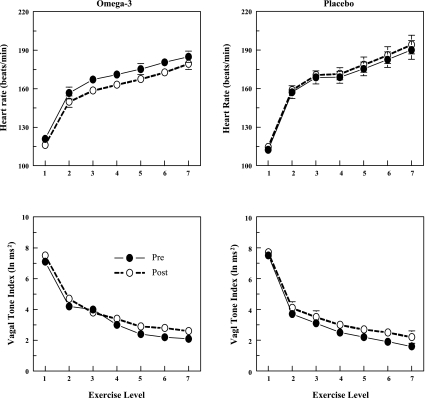Fig. 4.
Effect of n-3 PUFAs on the heart rate and heart rate variability response to submaximal exercise. As there were no significant differences noted between the various n-3 PUFA doses, these data have been combined. Dietary n-3 PUFA, but not the placebo, produced a significant downward shift of the heart rate response curve that was accompanied by an upward shift in the high frequency component of the R-R interval variability (vagal tone index: 0.24 to 1.04 Hz; i.e., significant pre-post effect). Despite the shifts in the curves, the absolute change in these variables induced by the exercise was not altered before or after the treatment (i.e., there was no significant pre-post treatment × exercise interaction). Data were averaged over the last 30 s of given exercise level. Exercise levels were as follows: 1 = 0 kph and 0% grade; 2 = 4.8 kph and 0% grade; 3 = 6.4 kph and 0% grade; 4 = 6.4 kph and 4% grade; 5 = 6.4 kph and 8% grade; 6 = 6.4 kph and 12% grade; 7 = 6.4 kph and 16% grade. Pre, before placebo (n = 16) or n-3 PUFA (1–4 g/day, n = 35) treatment began; post, after 3 mo of treatment.

